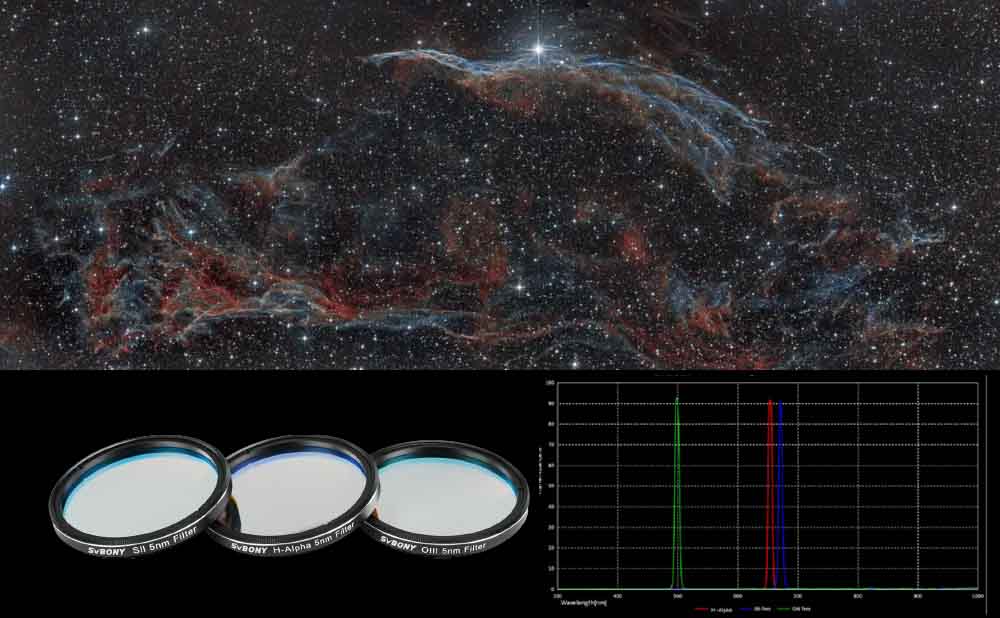Blog
Table of Contents

Best Astronomy Filters for Astrophotography in 2024
Unlock the full potential of your astrophotography with the best 2-inch light pollution filters. In this guide, we'll explore the most popular filters among astronomers, including UHC, CLS, and Narrowband Filters. Elevate your celestial imaging by choosing the perfect filter for your equipment.
1. Light Pollution Filter:
It is a revolutionary addition to astrophotography and stargazing. It can effectively reduce the impact of artificial light on celestial observations. It is designed to selectively block specific wavelengths of light emitted by common sources of light pollution, such as streetlights and urban areas. By filtering out these unwanted wavelengths, meanwhile with a multi-layer coating and innovative design, the filter enhances contrast and visibility of astronomical objects, such as ebulae and galaxies, allowing for clearer and more detailed views of the night sky.

-
2. UHC Filter:
- UHC (Ultra High Contrast) filter is tailored for revealing deep-sky details. It is designed to selectively transmit specific emission lines associated with these celestial objects, while blocking other unwanted wavelengths of light, including light pollution and skyglow. By reducing the background brightness and enhancing the contrast, the UHC filter allows astronomers and stargazers to observe these faint and diffuse objects with greater clarity and detail. Its advanced coating technology enhances contrast while effectively suppressing light pollution. Capture nebulae, galaxies, and star clusters with improved visibility and clarity.

3. CLS Filter:
The CLS (City Light Suppression) filter is crafted to improve visibility in light-polluted urban environments. Its broadband filter selectively reduces light pollution wavelengths, boosting contrast and details for deep-sky imaging. The CLS filter is a reliable choice for astrophotographers in challenging locations.
4. Narrowband Filters:
Narrowband Filters are designed for narrowband imaging, emphasizing specific wavelengths. Unlike broad-spectrum filters that allow a wide range of wavelengths to pass through, narrowband filters are designed to transmit only very specific emission lines associated with certain elements or molecules present in the object being observed. These filters typically target specific wavelengths such as hydrogen-alpha (Hα), oxygen III (OIII), and sulfur II (SII). By isolating these specific wavelengths, narrowband filters effectively block out other unwanted light sources, including light pollution, moonlight, and background noise. This allows astrophotographers to capture detailed images of nebulae and other deep-sky objects with enhanced contrast and clarity, even in areas with significant light pollution. Here we recommend SVBONY SV220 dualband filter 7nm nebula 2 inch, which is famous and popular among the astronomers.

5. SHO Filters 5nm:
The SVBONY SV227 2″ SHO Filter Set consists of three mounted astrophotography filters designed to allow narrowband light transmission within a 5nm band. These filters are specifically tailored for capturing ionized sulfur (SII) at 672nm, hydrogen-alpha (H-alpha) at 656.3nm, and ionized oxygen (OIII) near 500.7nm.

When used in conjunction with a monochrome astronomy camera, individual images taken with each filter can be combined using standard processing techniques to produce high-contrast images of various celestial objects such as emission nebulae (e.g., Orion, Lagoon, and Eagle Nebulae), planetary nebulae (e.g., Ring, Dumbbell, and Helix Nebulae), and supernova remnants like the Veil Nebula.

the sv227 sho filter reviews by Cuiv, the lazy geek
The filters in this set effectively block ultraviolet (UV) and infrared (IR) light to ensure sharp star images. Each filter in the set is 1.85mm thick, and fully multicoated to ensure optimal image quality. With peak transmission exceeding 90% at each passband, the SV227 narrowband SHO filter set is ideally suited for use with monochrome cameras and manual or electronic filter wheels compatible with SV226 filter drawers or SV133 2inch filter-wheels.
Conclusion:
Whether you're a beginner or an experienced astrophotographer, choosing the right filter can make a significant difference in your celestial imaging endeavors. So don't let light pollution hinder your astronomical adventures—explore the wide range of options available and find the perfect filter that suits your equipment and observing conditions.
Happy stargazing!


There are no customer reviews yet . Leave a Reply !